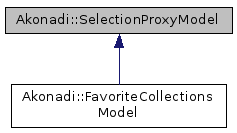akonadi
#include <selectionproxymodel.h>

Public Member Functions | |
| SelectionProxyModel (QItemSelectionModel *selectionModel, QObject *parent=0) | |
Detailed Description
A proxy model used to reference count selected Akonadi::Collection in a view.
Only selected Collections will be populated and monitored for changes. Unselected Collections will be ignored.
This model extends KSelectionProxyModel to implement reference counting on the Collections in an EntityTreeModel. The EntityTreeModel must use LazyPopulation to enable SelectionProxyModel to work.
By selecting a Collection, its reference count will be increased. A Collection in the EntityTreeModel which has a reference count of zero will ignore all signals from Monitor about items changed, inserted, removed etc, which can be expensive operations.
Example:
See Integration in your Application for further guidance on the use of this class.
- Since
- 4.4
Definition at line 99 of file selectionproxymodel.h.
Constructor & Destructor Documentation
|
explicit |
Creates a new selection proxy model.
- Parameters
-
selectionModel The selection model of the source view. parent The parent object.
Definition at line 74 of file selectionproxymodel.cpp.
The documentation for this class was generated from the following files:
Documentation copyright © 1996-2014 The KDE developers.
Generated on Tue Oct 14 2014 23:00:29 by doxygen 1.8.7 written by Dimitri van Heesch, © 1997-2006
KDE's Doxygen guidelines are available online.
 KDE API Reference
KDE API Reference